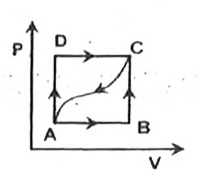Heat and work are ''definite quantities''.
Heat and work are not properties of a system. Their values depend on the path of the process and vary accordingly.
If both the statements are TRUE and STATEMENT-2 is the correct explanation of STATEMENT-1
If both the statements are TRUE but STATEMENT-2 is NOT the correct explanation of STATEMENT-1
If STATEMENT-1 is TRUE and STATEMENT-2 is FALSE
If STATEMENT-1 is FALSE and STATEMENT-2 is TRUE
The correct Answer is:D
Step by step video, text & image solution for Heat and work are ''definite quantities''. Heat and work are not properties of a system. Their values depend on the path of the process and vary accordingly. by Chemistry experts to help you in doubts & scoring excellent marks in Class 11 exams.
Updated on:21/07/2023Topper's Solved these Questions
- THERMODYNAMICSBOOK - NARENDRA AWASTHICHAPTER - THERMODYNAMICSEXERCISE - Level 1 (Q.1 To Q.30)
6 Videos
- THERMODYNAMICSBOOK - NARENDRA AWASTHICHAPTER - THERMODYNAMICSEXERCISE - Level 1 (Q.31 To Q.60)
2 Videos
- STOICHIOMETRYBOOK - NARENDRA AWASTHICHAPTER - STOICHIOMETRYEXERCISE - Level 3 - Subjective Problems
20 Videos
Similar Questions
Knowledge Check
A system is provided 50 J of heat and work can be done on the system is 10 J. The change in internal energy during the process is:
A40 JB60 JC80 JD50 JA system is provided 50 joule of heat and work done on the system is 10 J. The change in internal energy during the process is
A40 JB60 JC80 JD50 JThe work done by a system is 8 J, when 40 J heat is supplied to it. The change in internal of the system during the process
A48 JB40 JC32 JD44 J
Assertion : Work is a state function.
Reason : Work does not depend upon the path.
View SolutionWhat are the quantities on which the amount of work done depends ? How are the related to work ?
View SolutionIn the adjoinign P-V diagram, 100 J of heat is given in taking a system from A to C along the path ADC and 50 J of work is done by system in this path.
a. If the work done by the suystem is 15 J along the path ABC, then how much heat is to be given in taking the system from A to C along ABC?

b. How much heat will be absorbed or given out if the work done on the system along the curved path from CA to A is 15 J?
c. If UB−UA=40J, then how much heat will be absorbed in each process AB and BC?
View SolutionStatement-1: There is a natural asymmetry between work to heat and converting heat to work .
Statement-2: No process is possible in which the sole result is the absorption of heat from a reservoir and its complaete conversion into work .
View SolutionStatement-I : There is a natural asymmetry between converting work to heat and converting heat to work.
Statement-II : No process is possible in which the sole result is the absorption of heat from a reservoir and its complete conversion into work.
View Solution
